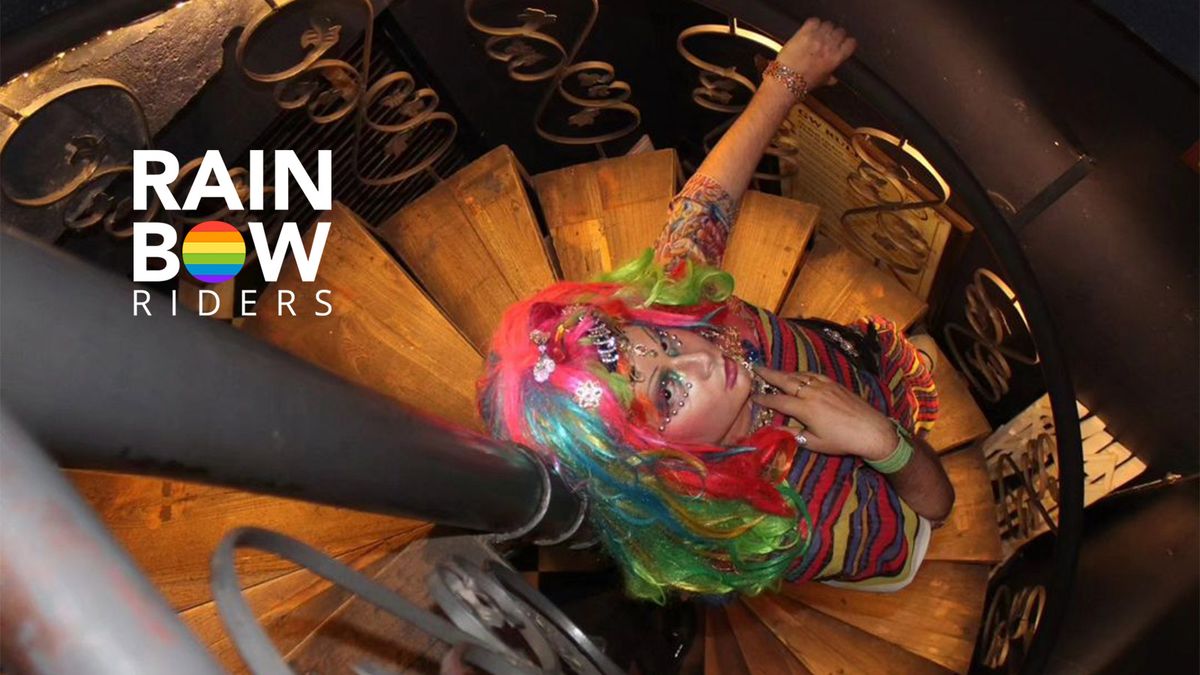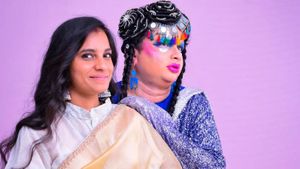When Patruni Chidananda Sastry first came out as gender fluid in 2018, right after the decriminalisation of Section 377, not many really knew what it meant. He chose to come out to the whole world through an advert in the newspaper. “Coming out is a continuous process. My parents gave me time and were patient in trying to understand and learn about my journey,” recounts Patruni. With time, he became more comfortable with one label and started exploring and understanding his sexual orientation. Recalling how coming out as a pansexual got him unconditional love and support, Patruni says, “I opened up about my sexuality as a pansexual to my family, which was also a similar journey. Coming out to my partner before marriage was indeed an important coming out experience where I received unconditional love and support.”
This Pride Month, in a candid conversation with Zee Zest, Telangana’s first drag queen shares what it’s like to be a drag queen in India, how he finds freedom through drag, his makeup essentials and a lot more.
1. What's it like to be a drag queen in India?
Being a drag artist in India at this time actually makes me feel very important. Drag queens are the visible embodiment of queerness, where queerness is celebrated in its full form. Drag has helped us define our own gender expression and has provided an image of what gender can look like. Politically, we are pushing for the right to gender expression and overall trans rights. Drag is now very important in India as it gives a stronger voice to queer people in an artistic way, without having to hold placards or protest. Simply by walking and doing drag, we are fighting against heteronormativity and a homophobic environment, while asking for a more inclusive space.
2. How did you find freedom through drag?
I feel that drag helps me attain gender euphoria. As a non-binary person, I become the canvas of gender, and drag allows me to exaggerate and express how we should perceive gender in society. Time and again, drag has helped me with various challenges, especially recently when I became a parent and experienced loneliness and postpartum depression. It was crucial for me to embrace drag as a means of distraction, allowing me to trust my partner in providing support for our newborn child and helping to overcome feelings of loneliness and depression.
3. Who inspires you as a drag queen?
I seek inspiration from a variety of drag queens. Charity Kase is one drag artist I look forward to sharing my drag with. I admire and find motivation from Sushant Divgikar, who has paved the way for Indian drag queens across the world and has been a huge support system for younger drag queens in India. I appreciate the artistry of Lawhore Vagistan, also known as Kareem Khubchandani, and the way they blend femininity and art together, creating a space for me to explore and learn.
4. How much does it cost for a drag queen to get into character?
Drag can be quite expensive, unless you opt for a more budget-friendly approach like me. However, it's not just about the money spent, but rather the commitment and resourcefulness that make a drag queen serve a look. I usually allocate a budget each year to expand my wardrobe with new clothes and wigs. Since I often perform without pay or with minimal pay, it can be challenging to cover the costs from my own pocket. I also reuse and recycle items, as drag can be sustainable. The most expensive drag accessories are wigs and makeup, so I find alternative ways to create looks and make them work.
5. Can you give us a peek into your makeup bag as a professional drag queen?
My makeup bag consists of a range of products. I have traditional Indian stage makeup, which includes kajal, pan sticks, and pancakes in various colours. I also have a dedicated bag for body paint and face painting kits, which I use to create exaggerated makeup looks. Additionally, I carry a pouch full of glitter and nails. My makeup bag tends to look quite messy due to the constant wear and tear that comes with being a drag queen.
6. What are your must-have makeup essentials?
For me, the must-haves are moisturiser, a good primer, a foundation that matches my skin tone, a well-pigmented eye colour palette, a dark brown bronzer, and a bold red lipstick. I wouldn't start my makeup without having a pack of wet wipes on hand.
7. Do you have a beauty ritual that you religiously follow?
Yes, I religiously glue down my eyebrows and always finish my makeup with lipstick and gloss. I also prefer to use my hands to blend highlighter. Additionally, I always make sure to smell good, so I complete my look with a scented perfume.
8. What are your thoughts on the Supreme Court reserving its judgement on same-sex marriages in India?
I believe it's high time we achieve marriage equality, as it would not only benefit gay or lesbian couples but also the overall queer community, especially transgender and bisexual individuals in a marital setup. As a bisexual trans person myself, I often find it challenging to conform to conventional marriage norms and roles since they are not recognised. It's not a happy experience to hide my sexuality while navigating non-queer and toxic heterosexual spaces. Legalising same-sex marriages would make unions like ours ethical and ensure protection under the law.
9. How are the audiences responding to the shows and dances you're performing?
Recently, I've noticed more acceptance from people, especially heterosexuals and allies. They are becoming more open to the idea of gender performance, which gives me hope. I intentionally perform in public spaces like bus stops, railway stations, and other common access areas to help normalise the art form. When I do, I see people becoming curious, asking questions about drag, and showing support. Drag is for everyone, it's not always sexual, and it caters to different age groups. It's crucial for us to create a space for everyone.
10. Do you think drag performances are only for the LGBTQIA+ community?
No, that's a misconception. Drag is for everyone, including the heterosexual community. I believe that if a cisgender man engages in drag, it can make them more empathetic towards diverse gender groups. All the atrocities happening to women, trans women, and the presence of homophobia can be curtailed if we offer drag as a therapeutic practice. It allows cisgender men to examine and challenge their privilege by stepping into our shoes and experiencing what we feel.
11. Do you think India has started to give its drag queens the recognition they deserve?
I see drag growing in India, with more drag artists emerging from multiple cities and towns. However, I don't think drag queens have received the recognition they deserve just yet. I believe people need to support their local drag artists, as that is the true recognition they can receive for their art form. While social media and numbers often highlight only a few drag artists, many others are creating their own shows, making a regional impact, and bringing unique perspectives. They also deserve equal opportunities and space to present their art. There should be a healthy exchange of artists from non-metro cities to metro cities, where drag queens who may not have as many resources in their own towns or cities can come and perform, creating their own niche and learning from the legends. Organisers and patrons need to look beyond their comfort zones and provide more opportunities for upcoming artists to shine and learn.
12. What's the future of drag as an art form in India?
Drag is experiencing exponential growth in India. In 2019, there were only a handful of drag artists, but in recent years, over 1,000 drag artists have emerged, each bringing their unique style and empowering the LGBTQ+ community. The future of drag lies in recognising and celebrating these artists who are carving their own niche in cities like Visakhapatnam, Chennai, Bengaluru, Indore, Chandigarh, Kanpur, and many other tier one and tier two cities. It's high time we acknowledge their contributions and provide them with the limelight they deserve. The drag scene in India is evolving rapidly, and it holds immense potential to create a platform for diverse voices and foster greater acceptance and understanding of gender performances and queer culture within society.
13. You are probably the first-ever drag queen in India who is also becoming a biological dad. How does it feel? What are the challenges you faced? And how did you overcome them?
I believe it was indeed a very difficult journey, especially because I hadn't seen anyone I could look up to while navigating the complexities of raising a child with labels like bisexuality and drag. Parenthood is often seen through a narrow lens, with the focus primarily on mothers. During this time, I experienced postpartum depression and anxiety, which cast a dark cloud over what should have been a joyous occasion. However, amidst the storm, I found refuge in the vibrant world of drag. In the sea of advice and expectations, drag became my compass, guiding me towards authenticity and self-assurance. It reminded me that parenting is not about being perfect but about being present and nurturing the unique individuality of my child. My partner, a remarkable woman and a wonderful mom, stood by my side, offering unwavering support and understanding. Together, we faced the challenges head-on, creating a loving and accepting environment for our child. It's an incredible feeling to be a biological dad while also being a drag queen, and I'm grateful for the strength and resilience that both roles have brought into my life.



